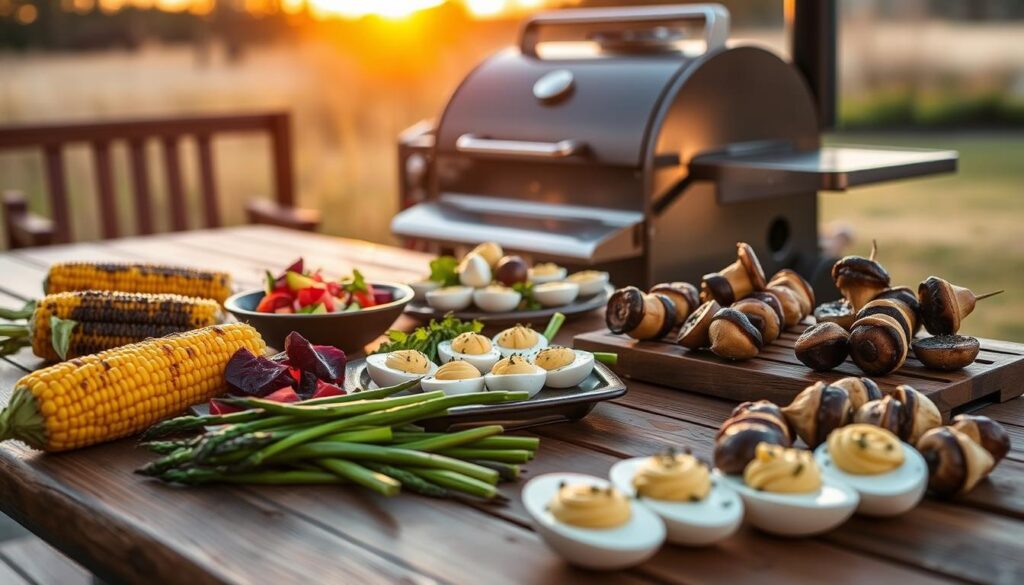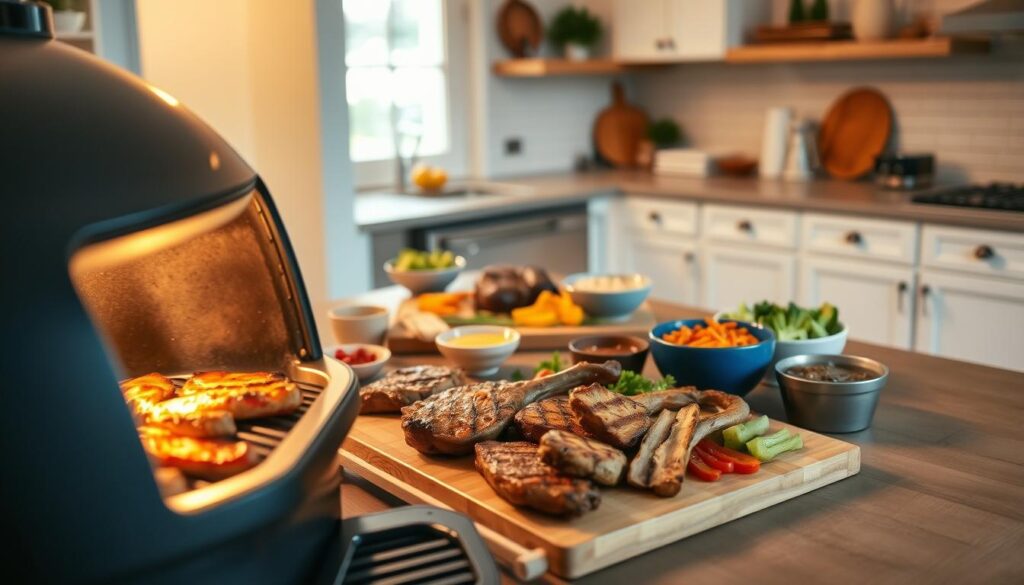Welcome to the ultimate guide to wood pellet smoker recipes. These recipes will change how you cook outdoors. Pellet grills offer precise temperature control and amazing flavor for dishes like smoked brisket and desserts.
Ready to improve your cooking skills? These pellet grill recipes will take your dishes to the next level. Whether you’re new to grilling or a pro, you’ll find these grills easy to use. They help you make delicious meals that will wow your family and friends.
Our collection includes smoky chicken thighs and decadent smoked mac and cheese. These recipes will encourage you to try new cooking methods and flavors. You’ll make dishes as good as those from restaurants, right in your backyard.
Key Takeaways
- Pellet grills offer unmatched flavor and cooking precision
- Wide range of recipes from meats to desserts
- Suitable for both beginners and experienced grillers
- Easy temperature control and consistent smoking
- Versatile cooking options for multiple dish types
- Opportunity to experiment with unique flavor profiles
Understanding Pellet Grill Cooking Fundamentals
Pellet grills have changed outdoor cooking. They offer precision and flavor that old grilling methods can’t. These machines mix technology with cooking art, making delicious smoked meats that wow everyone.
To cook well on a pellet grill, you need to know the basics. Modern pellet grills use advanced tech. This makes cooking easier and more consistent than ever.
Choosing the Right Wood Pellets
Wood pellets are key to flavor in pellet grill cooking. Each type of wood gives a different taste:
- Hickory: Bold, bacon-like flavor perfect for red meats
- Apple: Sweet, mild taste ideal for poultry and pork
- Mesquite: Intense flavor great for beef and game meats
- Cherry: Mild, fruity profile that complements most proteins
Temperature Control Basics
Getting the temperature right is key for great pellet grill cooking. New models have digital controls. These keep the heat steady.
| Cooking Method | Temperature Range | Best Uses |
|---|---|---|
| Low and Slow | 225-250°F | Smoking ribs, brisket, pulled pork |
| Medium Heat | 350-400°F | Roasting chicken, vegetables |
| High Heat Searing | 450-500°F | Steaks, burgers, quick-cooking meats |
Essential Pellet Grill Tools
Upgrade your pellet grill cooking with these tools:
- Digital meat thermometer
- Heat-resistant gloves
- Grill brush
- Aluminum drip trays
- Wireless temperature monitor
Learning these basic pellet grill techniques will change your outdoor cooking. You’ll make delicious smoked meats that everyone will love.
Essential Pellet Grill Recipes for Beginners
Starting with barbecue recipes can feel daunting. But, pellet smoker meals are great for beginners. They help you gain confidence and make delicious dishes that wow everyone.
Here are some easy-to-make pellet grill recipes for beginners:
- Smoked Baby Back Ribs: A classic dish that’s surprisingly simple to prepare
- Tender Smoked Chicken Thighs perfect for weeknight dinners
- Crowd-pleasing Smoked Queso Dip for appetizers
- Comfort-style Smoked Meatloaf with deep flavor profiles
Choosing the right wood pellets is key. Different woods add unique flavors to your dishes.
| Wood Pellet Type | Best Paired Meats | Flavor Profile |
|---|---|---|
| Hickory | Beef, Pork | Strong, Bacon-like |
| Apple | Chicken, Pork | Sweet, Mild |
| Mesquite | Beef, Game Meats | Intense, Earthy |
Pro tip: Start with lower temperatures and increase them slowly. This method ensures even cooking and rich, smoky flavors.
Mastering Smoked Meat Techniques
Getting into smoked meat recipes is more than just turning on your pellet grill. It’s an art that needs precision, patience, and skill. To become a pellet grill master, you must first learn the basics of meat prep and cooking.
Good pellet grill techniques start with picking the right meat and getting it ready. Here are some steps to improve your smoked meat:
- Choose high-quality, fresh meat cuts
- Trim excess fat carefully
- Apply a balanced dry rub
- Allow meat to reach room temperature before smoking
Proper Meat Preparation
Your smoked meat recipes will only be as good as your prep. Always use a reliable meat thermometer for accurate temps. Different meats need different approaches:
- Pork Ribs: Use the 3-2-1 method for tender results
- Beef Brisket: Trim fat cap to about 1/4 inch thickness
- Chicken: Brine for extra moisture and flavor
Smoking Times and Temperatures
Mastering pellet grill techniques means knowing how to control temperature. Low and slow is key for most smoked meats. Here’s a quick temperature guide:
- Pork Ribs: 225°F for 5-6 hours
- Beef Brisket: 250°F for 10-12 hours
- Chicken: 275°F for 2-3 hours
Resting and Serving Tips
The last key step in your smoked meat recipes is letting the meat rest. This lets juices spread out, making it tender. Usually, rest your meat for 15-30 minutes before slicing and serving.
Pro tip: Wrap your smoked meat in butcher paper or aluminum foil during resting to maintain temperature and moisture.
Mouthwatering Pellet-Smoked Chicken Dishes
Discover the secrets to making amazing pellet grill recipes. These recipes turn simple chicken into mouthwatering barbecue dishes. Your pellet grill is now a key tool for cooking juicy, smoky chicken that wows everyone.
Learning to cook chicken on a pellet grill is all about mastering a few key techniques. The right wood pellets and controlling the temperature are crucial for perfect smoked chicken.
- Southwest Chicken Wraps: A flavor-packed pellet grill recipe
- Smoked Chicken Wings: Crispy game-day favorite
- Whole Smoked Chicken: Tender and juicy centerpiece
To make the best Southwest Chicken Wraps, start with boneless chicken breasts and thighs. Season them with McCormick Grill Mates Roasted Garlic & Herb Spice. Then, marinate with Chipotle Pepper Marinade, olive oil, and water.
| Ingredient | Quantity |
|---|---|
| Chicken Breasts | 2 pieces |
| Chicken Thighs | 2 pieces |
| Flour Tortillas | 4 pieces |
Smoke your chicken at 300°F (149°C) until it reaches 160°F for breasts and 180°F for thighs. The secret to great barbecue is patience and keeping a close eye on the temperature.
Build your wraps with smoked chicken, red onion, cherry tomatoes, bell peppers, romaine lettuce, corn, cilantro, and avocado. Try adding black beans or tofu for different protein choices.
Pro Grill Master Tip: Always let your smoked chicken rest for 10 minutes before slicing to retain maximum juiciness!
Ultimate Pellet Grill Recipes for Special Occasions
Take your cooking to new heights with amazing pellet grill recipes. These recipes turn simple gatherings into unforgettable meals. Wood pellet smoker recipes are versatile, making dishes that wow your guests and delight their taste buds.
Holiday Favorites
Make your holiday meals unforgettable with these pellet grill recipes. Try a succulent smoked turkey or a glazed ham with smoky flavors. These dishes will impress your family and friends.
- Smoked Thanksgiving Turkey with Herb Butter
- Maple-Glazed Holiday Ham
- Christmas Smoked Prime Rib
Weekend Gathering Specialties
Wood pellet smoker recipes are perfect for weekend gatherings. Pulled pork and beef brisket are crowd-pleasers. Serve them with homemade barbecue sauce for extra flavor.
| Recipe | Cooking Time | Temperature |
|---|---|---|
| Pulled Pork | 10-12 hours | 225°F |
| Beef Brisket | 12-14 hours | 250°F |
Competition-Style Recipes
Challenge yourself with competition-inspired dishes. Try smoking Smoked Shotgun Shells or making award-winning ribs. These recipes will make you feel like a pro pitmaster.
- Smoked Candied Bacon
- Apple Jalapeño Smoked Ribs
- Bacon Jalapeño Popper Chicken Bombs
Whether it’s a holiday feast, weekend barbecue, or cooking competition, these recipes will impress. They’ll take your cooking skills to new heights and create unforgettable meals.
Smoky Side Dishes and Appetizers

Take your pellet grill recipes to the next level with these delicious side dishes and appetizers. They will make your outdoor cooking even better. Pellet smoker meals are not complete without amazing sides that add smoky flavor to every bite.
Must-Try Appetizers
- Smoked Cream Cheese: A quick and easy appetizer with a robust dry rub
- Smoked Deviled Eggs: Creamy and rich with intense smoky undertones
- Smoked Queso Dip with Chorizo: Spicy and creamy party favorite
Your guests will love these innovative pellet grill recipes. They turn classic appetizers into smoky sensations. The secret is choosing the right wood pellets to match each dish’s flavor.
Delectable Side Dishes
- Smoked Mac and Cheese: Creamy three-cheese delight
- Smoked Brussels Sprouts with Bacon: Crispy and savory
- Smoked Elote: Mexican street corn with a smoky twist
- Smoked Potato Salad: A cold side with unexpected depth
Mastering these pellet smoker meals means knowing about temperature control and wood pellet choice. Each recipe is a unique way to add smoky flavors to traditional sides. This makes your barbecue unforgettable.
Pro Tip: Timing is crucial when preparing side dishes alongside your main course. Coordinate your cooking to ensure everything comes off the grill perfectly!
Advanced Pellet Smoking Techniques
Take your pellet grill skills to the next level with these advanced techniques. Professional grillers use special methods to make simple meals into amazing dishes.
For top-notch wood pellet smoker recipes, you need to know advanced cooking tricks. These methods will boost your grilling skills and wow your guests with dishes that taste like they’re from a restaurant.
Reverse Searing Method
The reverse searing method changes how you cook thick meat. It works by:
- Smoking meat at low temperatures first
- Then searing it with high heat for a perfect crust
- Keeping it moist and adding great flavor
Cold Smoking Basics
Cold smoking lets you explore new flavors with your pellet grill. It involves smoking ingredients gently without high heat.
| Food Item | Cold Smoking Temperature | Recommended Wood |
|---|---|---|
| Cheese | Below 90°F | Apple or Cherry |
| Fish | 70-80°F | Alder or Maple |
| Cocktail Ingredients | Room Temperature | Hickory |
Multi-Zone Cooking
Make different temperature zones on your pellet grill to cook many dishes at once. This method lets you:
- Cook different meats at the same time
- Control how done each dish is
- Use your grill more efficiently
Pro tip: Use heat deflectors or adjust pellet feed rates to create precise cooking zones.
Quick and Easy Weeknight Pellet Grill Recipes

Busy weeknights need quick, tasty meals. Pellet grill recipes are perfect for fast dinners that impress. They don’t take hours to make.
Make your weeknights better with these fast pellet smoker meals. They taste like they’re from a restaurant. Pellet grills add smoky flavors quickly.
- Smoked Chicken Wings: A crowd-pleaser that takes just 45 minutes from start to finish
- Quick Pork Tacos with a smoky twist
- Creamy smoked cream cheese appetizer
Quick and tasty pellet grill recipes are possible. The trick is knowing how to control temperature and pick the right wood pellets. This way, you get great flavor in less time.
Top 3 Weeknight Pellet Grill Favorites
- Pellet Grill Smoked Chicken Wings
- Prep time: 15 minutes
- Cooking time: 30 minutes
- Wood pellet recommendation: Hickory or Apple
- Quick Smoked Pork Tacos
- Prep time: 20 minutes
- Cooking time: 45 minutes
- Wood pellet recommendation: Mesquite
- Smoked Cream Cheese Appetizer
- Prep time: 5 minutes
- Smoking time: 2 hours
- Wood pellet recommendation: Pecan
Pro tip: Prep ingredients ahead and use pre-made rubs to save time. Your pellet grill is a secret to making great meals in under an hour.
Tips for Perfect Smoke Ring and Bark Formation
Mastering pellet grill techniques is all about creating a stunning smoke ring and flavorful bark. Your smoked meat recipes will go from good to amazing with these cooking secrets.
The science behind smoke ring formation is cool. It’s a chemical reaction between meat’s myoglobin and carbon monoxide from wood smoke. Different woods give unique smoke flavors that change your meat’s look and taste.
Moisture Control Methods
Getting the perfect bark starts with managing moisture. Your pellet grill techniques should include:
- Using water pans to keep humidity up
- Spritzing meat now and then during cooking
- Patting meat dry before seasoning
Temperature Management Strategies
Keeping a steady temperature is key for a great smoke ring and bark. Try to keep your grill between 225°F and 250°F for the best results.
| Wood Type | Smoke Intensity | Flavor Profile |
|---|---|---|
| Hickory | Strong | Bold, bacon-like |
| Applewood | Mild | Sweet, fruity |
| Mesquite | Intense | Sharp, earthy |
Timing and Patience
The low and slow method is crucial in pellet grill techniques. Hurrying can make your meat tough and uneven bark.
“Patience is the secret ingredient in perfect barbecue.” – BBQ Pitmaster
Remember, thin, blue smoke means your grill is burning right. It’s the key to the best smoke rings in your smoked meat recipes.
Pellet Grill Maintenance and Care
Keeping your pellet grill in top shape needs regular care. Proper maintenance makes sure your grill works well and lasts longer. These tips will help you keep your grill in great condition and enjoy tasty meals for years.
- Routine Cleaning Process
- Scrub cooking grates with a wire-bristled brush
- Remove tough spots with a grill scraper
- Wash grates with warm soapy water
- Dry them well after cleaning
- Interior Maintenance
- Vacuum the firebox and fire pot
- Brush off debris
- Use a mild degreaser on surfaces
- Dry everything completely after cleaning
It’s also important to protect your grill’s outside. For stainless steel, use special cleaners and always wipe in the grain direction. Stay away from harsh materials that could damage the finish.
For more advanced care, consider these steps:
- Empty the hopper between uses
- Burn off leftover pellets at 400°F for 15 minutes
- Use a grill cover to shield from weather
- Season grates with high-temperature oil now and then
Pro tip: Regular maintenance prevents issues and extends your pellet grill’s life.
By following these maintenance tips, your pellet grill will be a trusted cooking partner for many delicious meals.
Conclusion
Your journey with pellet grill cooking is more than just learning. It’s about finding a world of outdoor cooking ideas. These ideas turn simple meals into amazing experiences. Pellet grills let you try many cooking methods, from slow smoking to quick grilling.
This makes you a confident home chef. As you get better, think about getting pellet grill cookbooks. They offer deep guidance and new recipes. These books help you control temperature, understand wood pellet flavors, and learn advanced techniques.
Each recipe is a chance to improve and make meals that people will remember. The secret to great pellet grilling is to keep learning and trying new things. Whether you’re cooking a tender beef tenderloin or trying new flavors, every time you cook is a chance to get better.
Trust your instincts and enjoy the tasty results of your growing skills. With time and effort, your pellet grill will become a key part of your cooking. Your barbecue journey is just starting, filled with tasty dishes and special moments at your table.
FAQ
What are the main advantages of using a pellet grill?
Pellet grills offer precise temperature control and versatile cooking options. They provide consistent smoke flavor and can cook a wide range of dishes. This makes them perfect for both beginners and experienced outdoor cooking enthusiasts.
How do I choose the right wood pellets for my recipes?
Choose wood pellets based on the food you’re cooking. Hickory is great for beef and pork. Apple wood is excellent for poultry and pork. Mesquite gives a strong flavor for beef, while cherry wood adds a milder, sweeter smoke.
Always use 100% hardwood pellets for the best results.
What temperature should I use for smoking different types of meat?
For most smoked meats, use temperatures between 225°F and 250°F. Beef brisket and pork shoulder need longer cooking times at lower temperatures. Chicken usually cooks best at slightly higher temperatures, around 275°F, for crispy skin.
How long does it take to learn pellet grill cooking?
Most people get comfortable with pellet grill cooking in a few tries. Start with simple recipes like chicken or pork. Then, move on to more complex dishes. Spend time learning your grill’s features and practicing temperature control.
Can I use a pellet grill for more than just smoking meats?
Absolutely! Pellet grills are very versatile. You can bake pizzas, desserts, roast vegetables, and make side dishes. They’re great for a wide variety of cooking styles, not just traditional barbecue.
How often should I clean my pellet grill?
Clean your pellet grill after every 2-3 uses, or at least once a season. Remove grease, clean the grates, empty the ash pan, and check the burn pot. A clean grill ensures better performance and prevents flavor contamination.
What are the best pellet grill brands for beginners?
Traeger, Green Mountain Grills, and Camp Chef are great for beginners. These brands offer easy-to-use models with good temperature control and reliable construction. Look for models with Wi-Fi and digital temperature controls for easier learning.
How do I prevent my smoked meats from drying out?
Use brining, spritzing during cooking, and wrapping in foil for longer cooks. Always let meats rest after cooking. Use a meat thermometer to avoid overcooking. Keeping meat moist is key to tender, juicy smoked meats.
Are pellet grills energy-efficient?
Pellet grills are more energy-efficient than traditional grills. They use precise pellet feed mechanisms and retain heat well. Modern models with digital controls help save fuel, making them environmentally friendly and cost-effective.
Can I use pellet grills year-round?
Yes, pellet grills work well in most weather. But, very cold temperatures might affect pellet feeding and temperature. Use a thermal blanket in winter, choose a sheltered location, and allow extra time for preheating.

